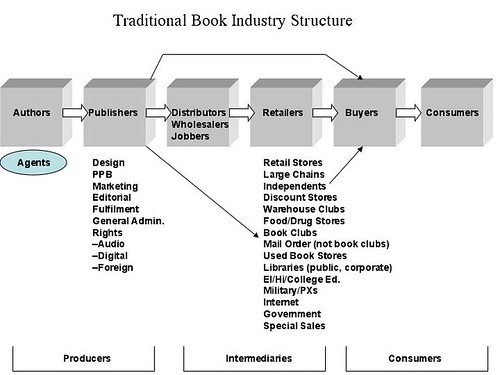The book industry is constantly evolving. Since the March 19, 2005 posting, I have added more detail to the value chain of traditional book publishing. The new diagram looks like this.

.
In reevaluating the value chain, it is valuable to break down the different constituencies: producers, distributors and consumers. For book producers, I've added agents to the value equation. I've also added rights management to the publisher's responsibilities.
The intermediaries' section is the most expanded. I lumped the wholesalers such as Ingram or Baker & Taylor, with distributors such as Publisher's Group West or Independent Publishers Group with jobbers. The retailer's section is greatly expanded to include discount stores, warehouse clubs, food & drug stores, military and PXs, libraries, mail order and used bookstores.
The consumer's section is further differentiated to distinguish between book buyers and book consumers. This better represents those book buyers who buy presents for others.
The additional complexity further demonstrates the archaic and Byzantine marketplace for books. The book industry, like the automobile industry, is one of the few industries to build a product on speculation without a specific customer in mind. And, like the auto industry, the book business suffers from overcapacity and lack of differentiation. According to
RR Bowker, there were 178,000 new books produced in 2005. The
BISG figures there are 65,000 separate publishers in the United States. Meanwhile, readership continues to decline. Is it any wonder that many books are remaindered or destroyed?
According to
Chris Anderson in his book,
"The Long Tail," the average book sells 500 copies. This is putting enormous pressure on the Book Industry infrastructure. Independent bookstores are closing at an alarming rate. Distributors are closing unexpectedly or merging with other distributors. Large chains, such as Borders, are reporting weak earnings and lower same-store sales.
Why, then, would anyone want to understand and navigate the complex Book Industry structure? Smart publishers are finding ways to by-pass the intermediaries and go directly to consumers. As this happens more frequently, the current Book Industry structure will topple and collapse under its own weight.
If you enjoyed reading this, please forward the URL to colleagues who might also enjoy it, http://bookprint.blogspot.com.

